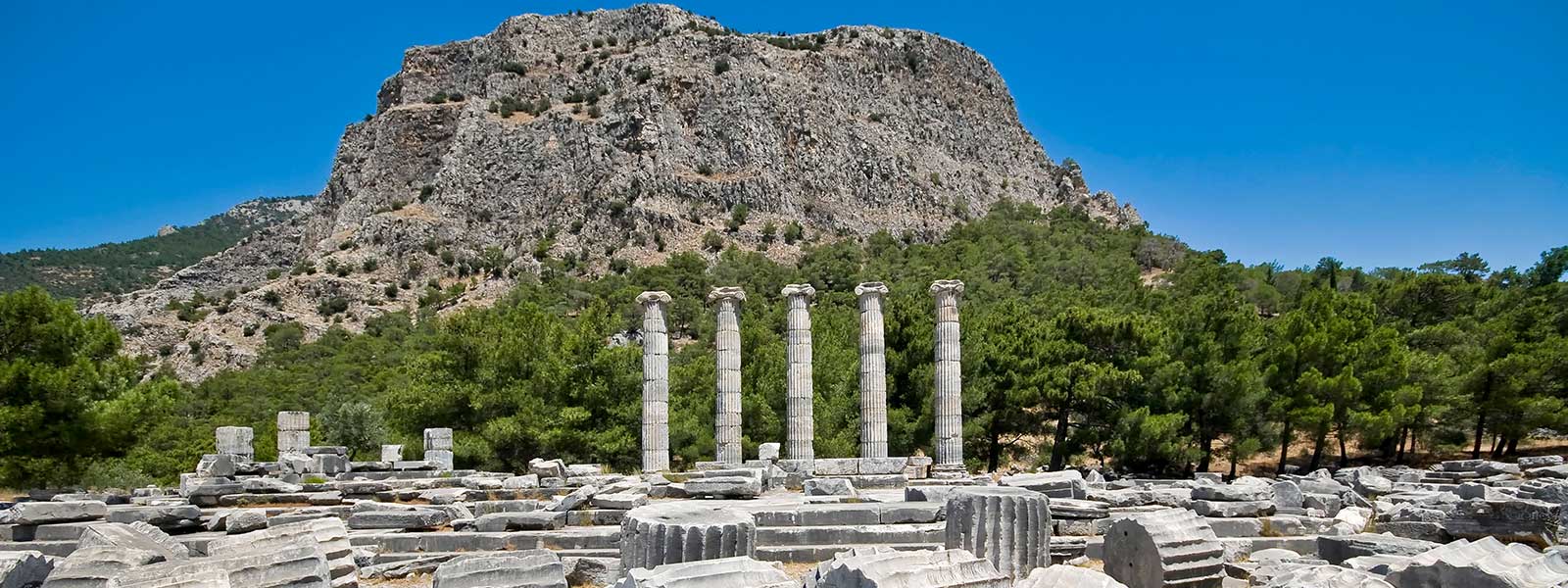
PRIENE
Priene possessed a great deal of famous Hellenistic art and architecture. The city’s original position on Mount Mycale has never actually been discovered; however, it is believed that it was a peninsula possessing two harbors. The city was arranged into four districts, firstly the political district which consisted of the Bouleuterion and the Prytaneion, the cultural district containing the Theatre, the commercial where the Agora was located and finally the religious district which contained sanctuaries dedicated to Zeus and Demeter and most importantly the Temple of Athena.
Priene, the birthplace of Bias, the famous 6th century BC philosopher who numbered among the seven wise men of classical antiquity, is a magnificent ancient city near Gullubahce southwest of Soke in the province of Aydin. The city has been described as the Pompeii of Anatolia on account of its well-preserved houses. It is not known when it was originally founded, and the earliest finds belonging to the city are coins bearing the head of Athena struck in the 5th century BC. The city we see today was rebuilt in the 4th century BC according to the grid plan of the famous architect Hippodamos of Miletus, to become one of the most beautiful cities of the Hellenistic age. The city's patron goddess was Athena. On the coast, then much closer than it is today, was the city's port, Naulokhos, but the site of this town has not yet been discovered. It was a member of the Panionic League of Ionian city-states, whose twelve members included Ephesus, Miletus, and Samos, and it was Priene which governed the leaguer religious and administrative center, the Panionion.
During the Roman Empire, it maintained its splendor, and under the Byzantines, it became, like Miletus, a leading diocese of Anatolia. By the end of the Byzantine era, however, the city had declined and was thereafter abandoned entirely. The first excavations here were carried out by Carl Humann in 1895 and archaeologists are still at work here today. The Temple of Athena is the loveliest of all Ionic temples. It was built in the 4th century by Pytheos, architect of the Mausoleum of Halicarnassus, one of the seven wonders of the world. The temple became rich on revenues from salt produced in salt pans on the coast. The theatre is one of the most imposing and best preserved Hellenistic theatres, with an estimated capacity of five thousand spectators. At the bottom of the tiers are five magnificent seats with arms reserved for people of high rank.
The other major structures at the site are the Bouleuterion or senate house which is in an excellent state of preservation and seated 640 people, and the Prytaneion just to the west where the city's sacred fire burned and the executive council conducted their affairs. There are two gymnasiums, known as the upper and lower gymnasiums, where the youth of the city were educated and trained in athletics. The lower gymnasium lies in the south part of the city and adjoins the stadium. As well as various reading and training rooms, there are well-preserved washrooms. The boys who studied here over two thousand years ago wrote their names on the walls of their classroom, just as schoolchildren today scratch their names on desks or walls.
One boy, for example, wrote, 'This is the place of Epikouros, son of Pausanias'. Other major buildings in the city include the temenos or sacred enclosure of the Egyptian gods, the Temple of Zeus, the Agora, the Temple of Demeter, the Rock Temple, the stadium, and several Byzantine buildings.
It holds an important place in the history of urban planning, as one of the cities where the grid plan of Hippodamus can be seen at its best. The houses of the city, like its monuments, are among the finest examples of the time. Most of the surviving villas where the wealthy citizens of Priene lived are situated just north of the Temple of Athena. The House of Alexander the Great on the West Gate Street was so-called because Alexander is known to have stayed here, and the building was later converted into a temple. Off the main streets like the West Gate Street, Temple of Athena Street, Theatres Street and Gate of the Spring Street, numerous side streets run at right angles. The city walls are in very good condition. The Acropolis stands on a hill just north of the city. When wandering through the ruins of ancient cities, images of the inhabitants of long ago going about their daily lives, with their own worries, joys, and sorrows, always come to mind In Priene, as you walk along the ancient streets, this sense of the past is even more haunting. As you sit on the steps of the theatre, the agora or the Temple of Athena, looking out over the plane stretching out into the distance below, remember that two thousand years ago most of that land was the sea. Then perhaps you might see a sailing ship gliding away towards Miletus.
